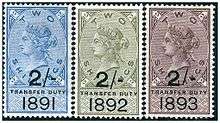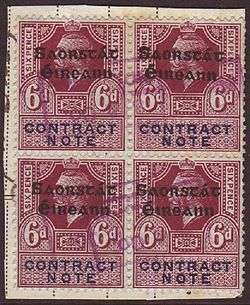Revenue stamps of the United Kingdom


The United Kingdom has been a heavy user of revenue stamps. The first revenues were issued before postage stamps were introduced, starting in the mid-eighteenth century. The last British revenues were Television Licence stamps issued in 1997.
Impressed Duty and embossed adhesive stamps

The first revenue stamps used in the United Kingdom were impressed duty stamps following the introduction of Stamp duty in the 1694 Stamp Act.
The Act was An act for granting to Their Majesties several duties on Vellum, Parchment and Paper for 10 years, towards carrying on the war against France (5 & 6 Will. & Mar. c. 21).[1] The duty ranged from 1 penny to several shillings on a number of different legal documents including insurance policies and documents used as evidence in courts. It raised around £50,000 a year and although it was initially a temporary measure, it proved so successful that its use was continued.
Successive Acts have created new duties up to the present day and impressed duty stamps have been used until recently to collect the taxes with electronic methods now taking over.
The tax was enforced by making the documents unenforceable in court if they had not been properly stamped. The tax was either a fixed amount per document or ad valorem where the tax varied according to the value of the transaction being taxed.[2]
Stamps were issued by the newly created Board of Commissioners of Stamps. Distributors of stamps were appointed throughout the country. Later, the poet William Wordsworth was the distributor in Westmorland.[2] The stamps were embossed on to the document directly, at first without any inking (known as albino), and later using colour. In the case of parchment the stamp was first applied to paper which was attached to the document using glue and a tin metal strip.[2]
General duty embossed adhesive stamps were issued in the mid-1850s, and some were also underprinted for a number of different taxes, like Bankruptcy and Customs. A few taxes used similar embossed stamps but these were inscribed directly and were not underprinted, like early Consular Service and Patent issues.
Keytypes and other types

From the 1870s to the 1980s most British revenue stamps were keytypes portraying the reigning monarch. Keytypes were used for many purposes, such as Contract Note and Passports.
A number of taxes had special designs which were only used for one specific purpose, such as National Insurance and Television Licence.
Local issues

Various parts of the United Kingdom also issued their own stamps for various duties, such as the towns of Chatham and Sheerness, Gloucestershire and Liverpool.
Ireland, Northern Ireland, Scotland and Southern Ireland also had some stamps for specific taxes which were different from those in the rest of the United Kingdom.
Colonies

Some British colonies used overprinted British revenues, either embossed or keytypes. Overprinted embossed adhesives were used by Barbados, the British Solomon Islands, Jamaica and Trinidad and Tobago. Keytypes were used in British Bechuanaland, Cyprus, the Trucial States and Weihaiwei.
Independent Ireland's first revenue issues in 1922 were British revenues overprinted with the words Rialtas Sealadach na hÉireann (Provisional Government of Ireland) or later Saorstát Éireann (Irish Free State).
British Inland Revenue stamps overprinted for Heligoland are presumed to be bogus.
Palestine used British postage stamps overprinted O.P.D.A. (Ottoman Public Debt Administration) and a new value in 1918.[3]
See also
- Booth Papers
- Contributions Agency Collection
- H.M. Customs and Excise Collection
- Revenue Society
- Postage stamps and postal history of the United Kingdom
- Turner Collection of Newspaper Tax Stamps
Further reading
- Catalogues by John Barefoot.
- Catalogues by Walter Morley.
References
- ↑ Russell, David Lee. The American Revolution in the Southern Colonies. McFarland & Company, 2000, p.27. ISBN 9780786407835
- 1 2 3 Barefoot, John., ed. Great Britain Revenues. 4th edition. York, United Kingdom: J. Barefoot Ltd., 2002, p.3. ISBN 0906845629
- ↑ Barefoot, John., ed. British Commonwealth Revenues. 9th edition. York, United Kingdom: J. Barefoot Ltd., 2012. ISBN 0906845726
External links
| Wikimedia Commons has media related to Revenue stamps of the United Kingdom. |
- UK Duty Stamps Scheme.
- I.B RedGuy GB Revenue stamp archive: A-E, F-L and M-U
- Great Britain Revenue Duties from 1694 to the Great Reform of 1853 Exhibit by Chris Harman RDP FRPSL
- British Foreign Bill Revenues 1854-1881 Exhibit by Dave Elsmore